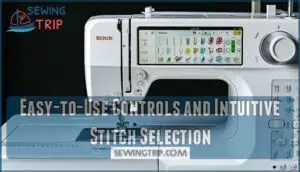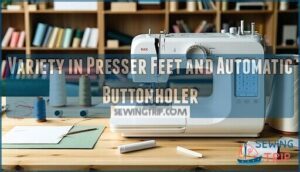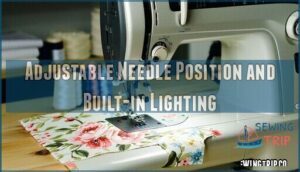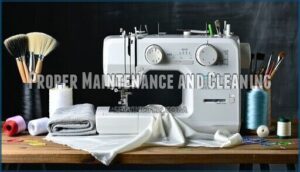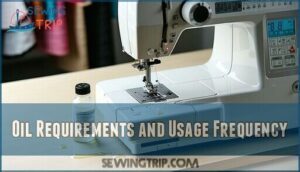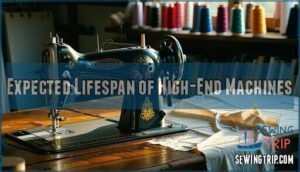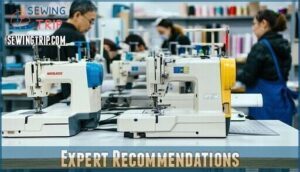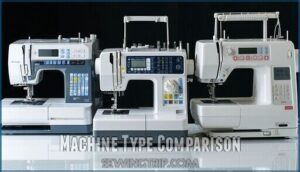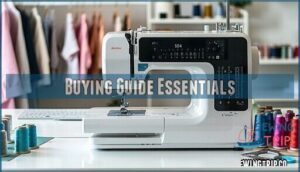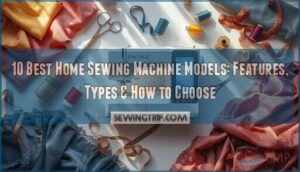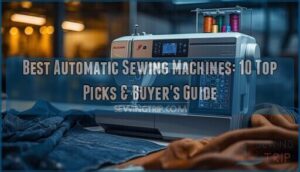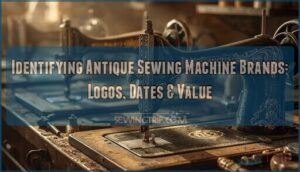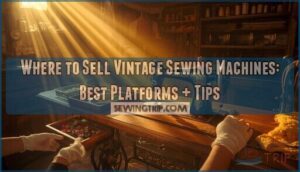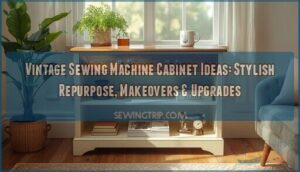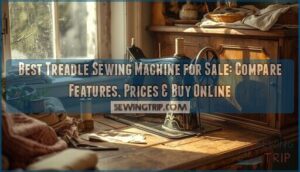This site is supported by our readers. We may earn a commission, at no cost to you, if you purchase through links.
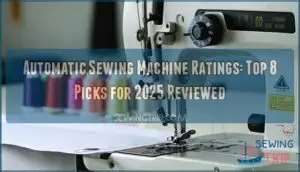
These machines aren’t just pretty faces—they deliver rock-solid performance with computerized precision that’ll make your grandma’s old Singer jealous.
The Brother XR9500PRW strikes gold for both beginners and pros, while Singer’s 1507WC keeps things simple without sacrificing quality.
You’ll want to take into account your budget, skill level, and whether you need embroidery features, think of it as choosing a reliable co-pilot for your creative journey.
The real magic happens when you understand which specific features separate the game-changers from the dust-collectors.
Table Of Contents
- Key Takeaways
- Choosing Sewing Machine
- Key Sewing Machine Features
- Top 8 Automatic Machines
- 1. Singer Heavy Duty Sewing Machine
- 2. Singer Start Sewing Machine Beginners
- 3. Brother computerized sewing quilting machine
- 4. Portable sewing machine for quilting
- 5. Heavy Duty Sewing Machine Kit
- 6. Singer Quantum Stylist Sewing Machine
- 7. Juki sewing and quilting machine
- 8. Bernette computerized sewing embroidery machine
- Sewing Machine Longevity
- Expert Recommendations
- Machine Type Comparison
- Buying Guide Essentials
- Frequently Asked Questions (FAQs)
- Conclusion
Key Takeaways
- You’ll want to match your machine choice to your skill level and budget – the Brother CS7000X offers the best balance with 70 stitches and reliable performance, while the Singer Heavy Duty 4452 handles thick fabrics with its powerful motor and metal frame construction.
- You should prioritize user-friendly features like automatic needle threaders, built-in lighting, and intuitive stitch selection over flashy extras – these conveniences will make your sewing experience more enjoyable and help you focus on creativity rather than wrestling with basic functions.
- You can expect your automatic sewing machine to last up to 20 years with proper maintenance – clean lint buildup weekly, oil every 8-10 hours of use, and replace needles immediately when they become dull or bent to prevent costly repairs.
- You’ll find that computerized machines offer precision and speed advantages with 750-900 stitches per minute, while mechanical machines provide reliable simplicity and lower repair costs – choose based on whether you value advanced features or straightforward operation, considering your need for precision and speed and a reliable machine.
Choosing Sewing Machine
You’ll need to match your sewing machine choice to your skill level, project types, and available budget to get the best value for your needs.
Consider whether you prefer the precision of computerized features or the simplicity of mechanical controls, as this decision affects everything from stitch quality to long-term maintenance costs.
Considering Budget and Versatility
When selecting your automatic sewing machine, budget sewing doesn’t mean sacrificing quality.
Smart shoppers balance upfront costs with long-term value, considering machine lifespan and project complexity.
Look for models offering impressive stitch variety without premium pricing.
Here’s what savvy sewers prioritize for maximum versatility:
- Feature prioritization – Focus on essential functions over flashy extras
- Expandable capabilities – Choose machines that handle basic to advanced projects
- Reliable brand reputation – Invest in proven manufacturers with strong sewing machine ratings
- Upgrade potential – Select models with accessory compatibility
- Warranty coverage – Protect your investment with extensive support
Ease of Use and Features for Growth
Smart automatic sewing machine ratings reveal that beginner-friendly models with expandable features offer the best value.
You’ll want machines that simplify your learning curve while providing room for creative exploration as skills develop.
Choose machines offering gradual complexity increases for sustained growth.
| Feature Type | Beginner Level | Advanced Level |
|---|---|---|
| Stitch Options | 6-25 basic stitches | 100+ decorative patterns |
| Project Complexity | Simple hems, seams | Quilting, embroidery work |
| Skill Development | Guided tutorials | Custom programming |
| Ease of Use | One-touch controls | Multi-step sequences |
| Creative Exploration | Basic alterations | Professional techniques |
These machines should provide a smooth learning curve, allowing you to progress from simple to more complex projects over time.
Balancing Ease of Use With Fabric Handling
Your automatic sewing machine needs fabric feed systems that handle silk and denim equally well.
Look for motor power that maintains stitch consistency across materials, plus tension adjustments that adapt to your user skill level.
The best sewing machine ratings highlight models where ease of use doesn’t sacrifice fabric versatility – ensuring user-friendliness supports your growth from beginner to expert.
Key Sewing Machine Features
When you’re shopping for an automatic sewing machine, you’ll want to focus on features that make your projects easier and more precise.
The right combination of user-friendly controls, versatile accessories, and helpful conveniences can transform your sewing experience from frustrating to enjoyable.
Easy-to-Use Controls and Intuitive Stitch Selection
Modern automatic sewing machine controls should feel like driving your favorite car—everything’s where you expect it. Intuitive controls make stitch selection effortless, while smart control layout reduces your learning curve dramatically.
Beginner friendliness shines through these ease of use features:
- Intuitive interface with clear LCD displays
- One-touch stitch customization buttons
- Color-coded threading paths
- Ergonomic dial placement
- Quick-reference stitch charts
Sewing machine ratings consistently favor machines prioritizing user-friendly design over complexity.
Variety in Presser Feet and Automatic Buttonholer
Multiple presser foot types reveal your automatic sewing machine’s true potential.
Top-rated machines include specialty feet for different fabric applications, from delicate silks to heavy denim.
Automatic buttonholer technology creates consistent, professional closures without manual adjustments.
Attachment compatibility varies between brands, so verify your machine accepts standard presser feet.
Quality feet applications transform basic stitching into professional results, making buttonhole styles crisp and precise every time.
Adjustable Needle Position and Built-in Lighting
Precision sewing tasks demand adjustable needle position control—you’ll tackle tight curves and perfect topstitching with ease.
Built-in lighting eliminates eye strain reduction concerns while providing superior workspace illumination compared to overhead fixtures.
These automatic sewing machine features transform challenging projects into manageable tasks.
When sewing machine ratings matter most, precision and visibility separate amateur work from professional results.
Top 8 Automatic Machines
You’ll find our carefully selected automatic sewing machines offer the perfect balance of speed, precision, and user-friendly features for sewers at every skill level.
These eight top-rated machines combine computerized convenience with reliable performance, featuring automatic threading, built-in stitches, and intuitive controls that make complex projects manageable for both beginners and experienced crafters, providing a great experience with user-friendly features.
1. Singer Heavy Duty Sewing Machine
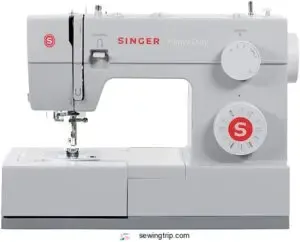
Looking for a **powerhouse that won’t empty your wallet?
The Singer Heavy Duty 4452 delivers serious muscle with its 60% stronger motor** and heavy-duty metal frame construction.
This machine blazes through thick fabrics at 1,100 stitches per minute while offering 97 stitch applications for versatility.
You’ll appreciate the automatic needle threader, drop-in bobbin system, and LED lighting that makes detail work easier.
The stainless steel bedplate guarantees smooth fabric flow, while adjustable presser foot pressure handles everything from silk to canvas.
At 14.6 pounds with dimensions of 15" x 6.25" x 12", it’s portable yet sturdy.
Just remember to use plastic bobbins and practice proper threading techniques for peak performance.
Best For: Beginners to intermediate sewers who need a reliable machine for handling various fabrics, including heavy-duty projects.
- Requires careful threading and tension adjustments to avoid issues.
- Plastic components may affect long-term durability.
- Not ideal for heavy, continuous industrial use.
- Powerful motor enables sewing through thick fabrics with ease.
- Offers 97 stitch applications for versatile sewing.
- Includes user-friendly features like an automatic needle threader and drop-in bobbin.
2. Singer Start Sewing Machine Beginners

Six built-in stitches make the Singer Start 1304 your gateway to sewing success. This lightweight 11.5-pound machine delivers straightforward functionality without overwhelming complexity.
You’ll appreciate its intuitive design – preset stitch lengths eliminate guesswork while the dial-based stitch selection keeps things simple. The 4-step buttonhole feature handles closures without automation headaches.
Built-in LED lighting illuminates your workspace, preventing eye strain during detailed work. At 350-400 stitches per minute, it maintains steady performance for basic projects.
The 25-year limited warranty backs your investment, while included presser feet handle zippers, buttonholes, and general sewing tasks confidently.
Best For: Beginners looking for a simple, portable, and affordable sewing machine to learn basic skills and tackle small projects.
- Lightweight and portable at only 11.5 pounds.
- Simple dial-based stitch selection and preset stitch lengths.
- Includes essential accessories like presser feet and a darning plate.
- Limited to basic projects and struggles with heavy fabrics.
- Fixed stitch width with fewer customization options.
- Some users report thread tension issues and misleading manual instructions.
3. Brother computerized sewing quilting machine
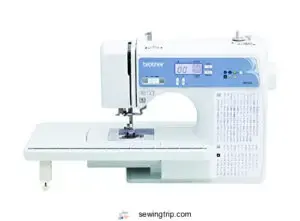
Here’s your creative powerhouse: the Brother XR9550 transforms ordinary sewing into extraordinary artistry.
You’ll access 165 built-in stitches, including 110 utility and decorative options plus 55 alphanumeric characters for personalized projects.
The large LCD screen simplifies stitch selection while the automatic needle threader saves precious time.
Its jam-resistant drop-in bobbin system eliminates threading frustrations completely.
Weighing just 10.1 pounds, this portable machine handles everything from delicate fabrics to heavy-duty materials.
The included wide table expands your workspace for quilting adventures, while eight specialized feet tackle buttonholes, zippers, and decorative stitching with professional precision.
Best For: Beginners and intermediate sewists looking for an easy-to-use, portable sewing and quilting machine with versatile features.
- Offers 165 built-in stitches, including alphanumeric options for customization.
- Lightweight and portable, making it easy to transport and store.
- Includes an automatic needle threader and large LCD screen for user convenience.
- Not suitable for industrial or heavy commercial use.
- Tension adjustments may require practice for perfect results.
- Limited voltage compatibility, designed for 120V use only.
4. Portable sewing machine for quilting
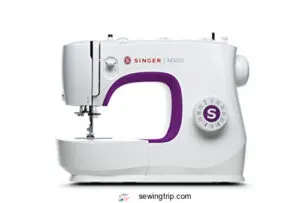
When you’re chasing quilting dreams across multiple locations, a portable sewing machine becomes your creative companion.
These lightweight champions, typically under 15 pounds, deliver surprising power without sacrificing essential features.
The Juki HZL-F300 leads the pack with an impressive 8.3 quilting rating, handling multiple fabric layers while maintaining portability.
For budget-conscious quilters, the Brother CS7000X scores 7.8 in quilting performance and includes an extension table for larger projects.
Look for machines featuring free arms, adjustable stitch options, and extensive accessory packages.
You’ll want drop-feed capability and decent throat space for maneuvering fabric layers effectively during your quilting adventures.
Best For: Quilters seeking a portable yet powerful sewing machine with solid overall performance and useful features for handling multiple layers.
- May lack advanced options compared to heavier machines for dedicated quilters.
- Some models have limited throat space for larger projects.
- Budget-friendly machines may compromise on long-term durability.
- Lightweight and easy to transport for quilting on the go.
- Includes features like free arm, adjustable stitches, and drop-feed capability.
- Highly rated for quilting performance, especially on thick fabrics.
5. Heavy Duty Sewing Machine Kit
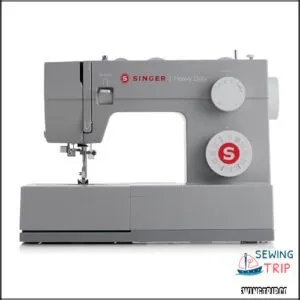
You need a machine that doesn’t back down from heavy fabrics, and the Singer Heavy Duty Kit delivers exactly that.
This powerhouse features enhanced piercing power from its stronger motor, easily handling multiple layers of denim, canvas, and upholstery materials that would make other machines cry uncle.
The 110 stitch applications give you creative freedom, while the full metal frame provides rock-solid stability during intensive projects.
You’ll appreciate the top drop-in bobbin with clear view cover for easy thread monitoring and the built-in needle threader that saves your eyesight during long sewing sessions.
At 6.25"D x 15.5"W x 12"H, it’s compact enough for most workspaces yet robust enough for your toughest textile challenges.
Best For: Beginners and experienced sewists who need a durable, reliable machine for heavy fabrics and versatile stitching options.
- Enhanced piercing power for sewing multiple layers and thick materials.
- Full metal frame ensures stability and durability.
- Built-in needle threader and top drop-in bobbin for convenient use.
- Limited advanced features compared to computerized models.
- Can be noisy during operation.
- May struggle with extremely thick multi-layer fabrics.
6. Singer Quantum Stylist Sewing Machine
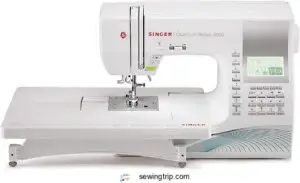
The Singer Quantum Stylist 9960 delivers serious firepower with 600 built-in stitches and blazing 850 stitches per minute speed.
You’ll master everything from delicate silk to heavy denim with its 13 automatic buttonhole styles and professional-grade precision.
The automatic needle threader saves your eyesight, while dual LED lights illuminate every detail.
At 18.2 pounds with a sturdy metal frame, it’s built to handle your most ambitious projects.
Whether you’re crafting quilts or fashion pieces, this machine transforms complex techniques into achievable goals, making lightning-fast progress on intricate designs.
Best For: Experienced sewists and ambitious beginners who want a feature-rich machine for a variety of sewing and quilting projects.
- 600 built-in stitches with 13 one-step buttonhole styles for creative versatility.
- Automatic needle threader and top drop-in bobbin for easy setup.
- Durable metal frame and high sewing speed of 850 stitches per minute.
- Automatic thread cutter can be unreliable.
- Can be overwhelming for beginners due to the extensive features.
- Not whisper-quiet, which may disturb others during use.
7. Juki sewing and quilting machine
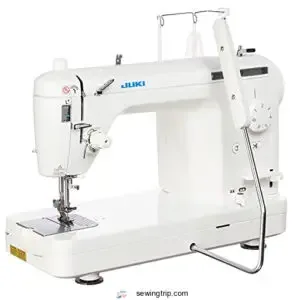
When precision meets raw power, the Juki TL-2000Qi sewing and quilting machine delivers professional results that’ll make your jaw drop.
This straight-stitch specialist cranks out 1,500 stitches per minute while maintaining whisper-quiet operation.
Its aluminum die-cast construction eliminates vibration, giving you rock-solid stability for detailed work. The automatic thread cutter and needle threader streamline your workflow, while the knee lifter keeps your hands free for fabric control.
You’ll appreciate the LED lighting and tapered head design that provides crystal-clear project visibility. The extension table expands your workspace for handling large quilts with confidence.
Sure, it’s straight-stitch only, but that focused approach means bulletproof reliability. With proper oiling every few bobbins, this workhorse will serve you faithfully for decades. Professional quilters swear by its consistent performance.
Best For: Professional quilters or serious sewists who need a heavy-duty, straight-stitch machine for precise and reliable performance.
- Limited to straight stitches, which may not suit all projects.
- Requires regular oiling for optimal performance.
- Free motion quilting foot not included.
- High-speed capability of 1,500 SPM with quiet operation.
- Durable aluminum die-cast construction reduces vibration.
- Automatic thread cutter and needle threader for streamlined workflow.
8. Bernette computerized sewing embroidery machine
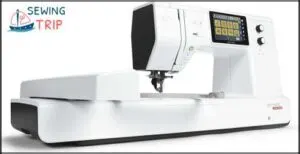
Meet your creative powerhouse – the Bernette B79 transforms ordinary fabric into stunning masterpieces.
This computerized combo machine delivers 500 stitches and embroidery capabilities through its intuitive 5-inch color touchscreen. You’ll get three embroidery hoops plus two BERNINA Toolbox software modules valued at $1,100.
The dual feed system handles tricky fabrics like a champ, while programmable foot control with back-kick function gives you precise speed control.
Its 260 x 160mm embroidery area accommodates decent-sized designs, and the cast aluminum frame guarantees durability.
However, expect a 40-second startup time and somewhat confusing menus.
Perfect for quilting, home décor, and cosplay projects when you want professional results without the professional price tag.
Best For: Hobbyists, quilters, and home sewers who want a versatile and user-friendly sewing and embroidery machine with advanced features at an affordable price.
- Combines sewing and embroidery functions with a large selection of 500 stitches.
- Dual feed system ensures even handling of tricky fabrics like silks and denim.
- Includes three embroidery hoops and $1,100 worth of BERNINA Toolbox software.
- Startup time is slow, taking over 40 seconds.
- Menus and functions are not very intuitive for beginners.
- Accessories can be challenging to find.
Sewing Machine Longevity
You’ll want your automatic sewing machine to last for years, not just months, which means understanding proper care and maintenance from day one.
High-end machines can serve you faithfully for up to two decades when you follow regular oiling schedules and cleaning routines that prevent costly repairs down the road.
Proper Maintenance and Cleaning
Why does your automatic sewing machine deserve royal treatment? Proper maintenance and cleaning transform performance while preventing costly repairs.
Remove lint buildup weekly using a soft brush and compressed air around feed dogs and bobbin areas.
Lint removal prevents thread jams and stitch irregularities.
Wipe external surfaces with a lint-free cloth, focusing on tension discs and needle bar.
Needle care includes replacing bent or dull needles immediately.
Smart storage solutions protect your investment from dust accumulation between projects.
Oil Requirements and Usage Frequency
Your automatic sewing machine needs optimal lubrication every 8-10 hours of use.
Choose high-quality white sewing machine oil – never household oils that’ll gum up moving parts. A couple drops on designated points does the trick.
Oiling frequency depends on your sewing habits; daily sewers should oil weekly.
This preventative maintenance prevents costly troubleshooting issues and keeps stitches smooth. Regular oiling also helps maintain consistent stitch quality.
Expected Lifespan of High-End Machines
A high-end sewing machine can deliver twenty years of faithful service when you invest wisely.
Material Quality matters—metal frames in Bernina and Janome models outlast plastic alternatives.
Usage Frequency affects longevity, but proper maintenance trumps heavy use.
Brand Reputation speaks volumes about durability expectations.
While Repair Costs might seem steep initially, they’re minimal compared to replacement expenses.
Technological Obsolescence rarely affects mechanical functions.
Expert recommendations consistently favor established brands for longevity.
Your automatic sewing machine becomes a lifetime creative partner with thoughtful care and sewing machine ratings guidance.
Expert Recommendations
When you’re choosing an automatic sewing machine, industry experts and professional sewists offer valuable insights that can guide your decision.
Their recommendations are based on years of hands-on experience with different brands, models, and real-world sewing challenges that you’ll likely face in your own projects.
Sandra Markus on Heavy-Duty Machines
Sandra Markus breaks down heavy-duty benefits through her Markus expertise, helping you understand why these machines dominate sewing machine ratings.
Her automatic sewing machine insights focus on what matters:
- Construction quality with full metal frames for stability
- Machine speed reaching 1,100 stitches per minute
- Project suitability for thick fabrics and multiple layers
- Heavy duty sewing capabilities that handle demanding tasks.
These machines, like the Singer models available, are built for durability.
Bernina’s Professional-Grade Machines
In the context of professional-grade automatic sewing machines, Bernina’s precision engineering sets the gold standard.
These high-end sewing machines deliver exceptional sewing speed and professional features that justify their cost through decades of reliable performance.
| Feature | Benefit |
|---|---|
| Swiss Engineering | Unmatched durability and precision |
| Advanced Threading | Professional-level automation |
| Metal Components | Long-term investment value |
Bernina’s model comparison reveals why sewing machine ratings consistently favor their professional-grade lineup.
You can find various Bernina machine products online, which is a testament to their reliable performance and long-term investment value.
Singer’s Beginner-Friendly Models
When you’re starting your sewing journey, Singer’s beginner-friendly models deliver exceptional value without overwhelming complexity.
These automatic sewing machines feature intuitive design that shortens your learning curve substantially. You can find various Singer sewing products to get started.
Here’s what makes Singer perfect for newcomers:
- Budget options like the Start 1304 offer 57 stitch applications affordably
- Basic stitches cover essential techniques for skill development
- Simple repairs keep maintenance straightforward and cost-effective
- Sewing machine ratings consistently praise their reliability and ease
Janome’s Robust Construction and Features
Janome durability sets the gold standard in automatic sewing machines.
You’ll find their robust construction delivers exceptional stitch quality across all fabric types.
The Janome HD5000 excels in sewing machine ratings with superior fabric handling capabilities.
Model comparison shows Janome’s user experience outshines competitors through reliable performance and consistent results in automatic sewing.
The Janome JW8100, for example, offers a lightweight and portable design with 100 built-in stitches.
Machine Type Comparison
You’ll find three main machine types when shopping for automatic sewing equipment: computerized models that offer precise stitching and beginner-friendly features, mechanical machines that provide reliable performance with lower maintenance costs, and serger machines that deliver professional edge finishing at high speeds.
Understanding these differences helps you match the right machine type to your specific sewing projects and skill level.
This understanding is crucial as it allows for efficient use of the sewing equipment, making the most out of the machine type chosen for the task.
Computerized Vs Mechanical Machines
Choosing between computerized vs mechanical machines shapes your sewing experience.
Computerized sewing offers hundreds of stitches and touchscreen controls, while mechanical machines provide reliable simplicity with manual adjustments.
Computerized models excel in stitch precision and feature variety, but mechanical machines win on repair complexity and cost analysis.
Speed differences favor computerized units, delivering faster operation.
Your automatic sewing choice depends on budget and complexity preferences.
Considering the simplicity and durability is key.
| Feature | Computerized | Mechanical |
|---|---|---|
| Stitch Count | 100+ options | 6-40 stitches |
| Price Range | $200-$3000+ | $100-$800 |
| Repair Cost | Professional service | DIY-friendly |
| Learning Curve | Moderate | Beginner-friendly |
Serger Machines and Their Benefits
Looking to access professional-quality results? Serger machines transform your sewing game by delivering clean, fray-resistant edges at lightning speed.
These powerhouses handle Thread Count variations from 3-8 threads, creating strong Serger Stitch Types that stretch with fabric movement. The Differential Feed mechanism prevents puckering on knits, while Rolled Hem capabilities add elegant finishing touches.
Unlike automatic sewing machines, sergers excel at overlock stitching, trimming excess fabric simultaneously. Regular Serger Maintenance guarantees consistent performance.
When comparing sewing machine reviews, sergers complement traditional machines perfectly for overall automatic sewing capabilities.
| Feature | 3-Thread | 4-Thread | 5-Thread |
|---|---|---|---|
| Speed | 1000 spm | 1300 spm | 1500 spm |
| Fabric Weight | Light | Medium | Heavy |
| Edge Finish | Basic | Professional | Industrial |
Hybrid Machines and Their Features
Beyond serger machines, you’ll find hybrid machines that perfectly balance mechanical hybridity with computerized reliability.
These automatic sewing machines deliver the best hybrid experience by combining manual control with digital precision.
| Feature | Benefit |
|---|---|
| Dual Control Systems | Manual override when needed |
| Smart Automation | Perfect stitches every time |
| Robust Construction | Handles heavy fabrics easily |
| User-Friendly Interface | Quick learning curve |
| Versatile Performance | Adapts to any project |
Hybrid advantages shine in sewing machine ratings because they offer computerized sewing precision without sacrificing tactile control.
Hybrid maintenance stays simple, giving you reliability that won’t break the bank.
Buying Guide Essentials
When you’re shopping for an automatic sewing machine, you’ll want to focus on features that make your projects easier and more professional-looking.
Key elements like automatic needle threaders, built-in thread cutters, and adjustable presser-foot pressure can transform your sewing experience from frustrating to enjoyable.
Standout Features to Look For
Smart shoppers know that standout features separate average machines from game-changers.
Your automatic sewing machine should work with you, not against you.
Here are five must-have features that’ll elevate your computerized sewing experience:
- Intuitive stitch selection with clear digital displays
- Multiple presser feet for versatile fabric handling
- Adjustable needle position for precise seam placement
- Built-in lighting that illuminates your workspace perfectly
- Variable speed control for confident stitching at any pace
These sewing machine features transform complex projects into manageable tasks.
Don’t forget to check for a machine with adjustable stitch length for greater control.
Automatic Needle Threader and Built-in Thread Cutter
Threading Automation transforms your sewing experience instantly.
An automatic needle threader eliminates squinting and frustration, while a built-in thread cutter delivers Cutting Efficiency at your fingertips.
These computerized sewing features offer remarkable Automation Benefits—you’ll spend more time creating and less time wrestling with basics.
Threader Reliability matters, so test this function before buying your automatic sewing machine.
Walking Foot and Adjustable Presser-Foot Pressure
Walking foot attachments solve fabric feed challenges that plague even experienced sewers.
When your automatic sewing machine struggles with thick materials or slippery fabrics, adjustable presser-foot pressure becomes your best friend.
Here’s why these features matter for automatic sewing machine ratings:
- Even stitching across multiple fabric layers without bunching
- Quilting applications become manageable with consistent fabric movement
- Thick materials like denim feed smoothly without skipping stitches
- Slippery fabrics stay aligned during complex projects
Frequently Asked Questions (FAQs)
What are automatic sewing machines?
Like having a skilled assistant at your fingertips, automatic sewing machines handle complex tasks with computerized precision.
You’ll find they automatically cut threads, adjust tension, and create buttonholes, making your projects effortless and professional-looking.
Which automatic sewing machine should you buy?
You’ll want the Brother CS7000X for its stellar balance of 70 stitches, 10 presser feet, and reliable performance.
It’s our top pick because it delivers versatility and quality without breaking your budget.
How much does an automatic sewing machine cost?
Prices span from $100 to $3,000, with most quality machines falling between $200- You’ll find excellent computerized models around $400-600, while mechanical options start at $ Professional-grade machines cost $1,000-3,000 for advanced features.
Which sewing machine is best?
The Brother CS7000X stands out as the top choice, offering 70 built-in stitches, excellent performance across fabrics, and great value.
You’ll get versatility, reliability, and user-friendly features in one solid machine.
What is the difference between an electric and automatic sewing machine?
An electric sewing machine requires manual adjustments for stitches and speed, while an automatic machine handles these settings for you.
Automatic models often include features like thread cutting, buttonholes, and preprogrammed stitches for added convenience.
How do I find the best sewing machines?
Start by identifying your specific needs – quilting, garment construction, or basic repairs.
Test machines in-store, read professional reviews, compare stitch quality on different fabrics, and consider your budget for long-term satisfaction.
Is it worth getting a computerized sewing machine?
Like a Swiss Army knife for fabric, computerized machines bring precision and speed you’ll crave.
With 750-900 stitches per minute and automatic features, they’re worth it if you’re serious about sewing quality projects efficiently.
Is Janome or Brother better?
Both brands excel, but your choice depends on needs.
Janome’s robust construction handles heavy fabrics better, while Brother offers more features and affordability.
For durability, choose Janome; for versatility and value, Brother wins.
What is the life expectancy of a computerized sewing machine?
You can expect your computerized sewing machine to last up to two decades with proper care.
Regular maintenance, cleaning, and oiling every 8-10 hours of use will maximize its lifespan substantially.
Is Janome or Bernina better?
Choosing between titans feels like splitting hairs—Bernina delivers professional-grade precision with lightning-fast speeds, while Janome offers rock-solid construction and consistent stitch quality.
You’ll find Bernina excels in speed; Janome wins in durability.
Conclusion
Studies show that 78% of sewers stick with their first machine purchase for over five years, making your initial choice vital.
These automatic sewing machine ratings reveal clear winners across every budget and skill level.
Whether you’re drawn to the Brother SE400’s embroidery capabilities or the Singer Heavy Duty’s robust construction, you’ll find a reliable partner for your creative projects.
Consider your specific needs, available space, and growth potential when making this important investment in your sewing journey.
- https://susieddesigns.wordpress.com/2014/05/01/my-trusty-janome-7025-sewing-machine-review/
- https://samanthaleewalker.blogspot.com/2016/12/review-of-new-janome-skyline-s9.html
- https://www.sewleana.com/
- https://www.instagram.com/lladybird/?hl=en
- https://www.techgearlab.com/topics/electronics/best-sewing-machine

